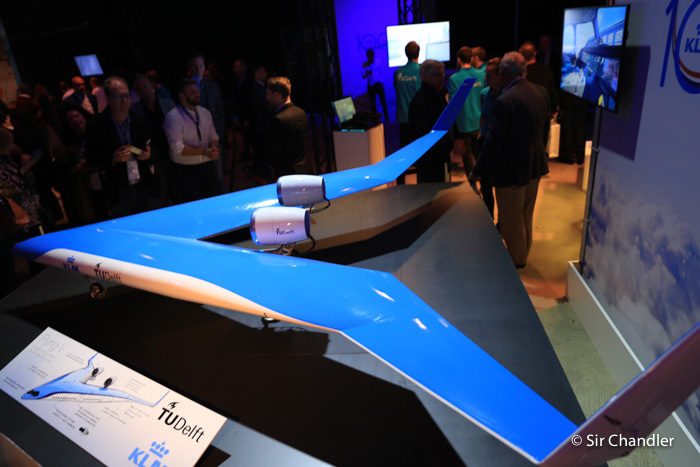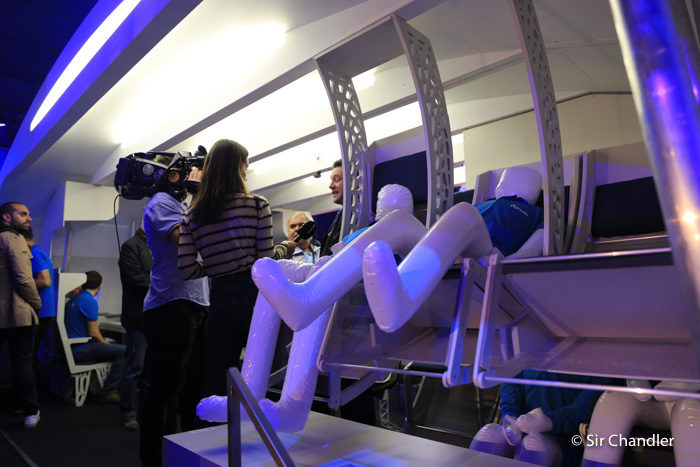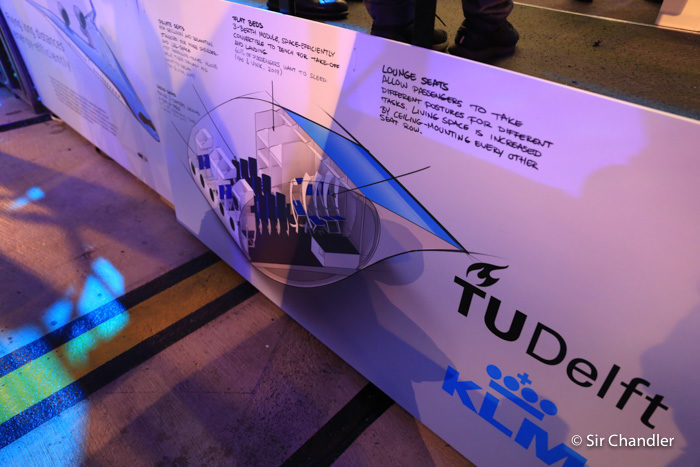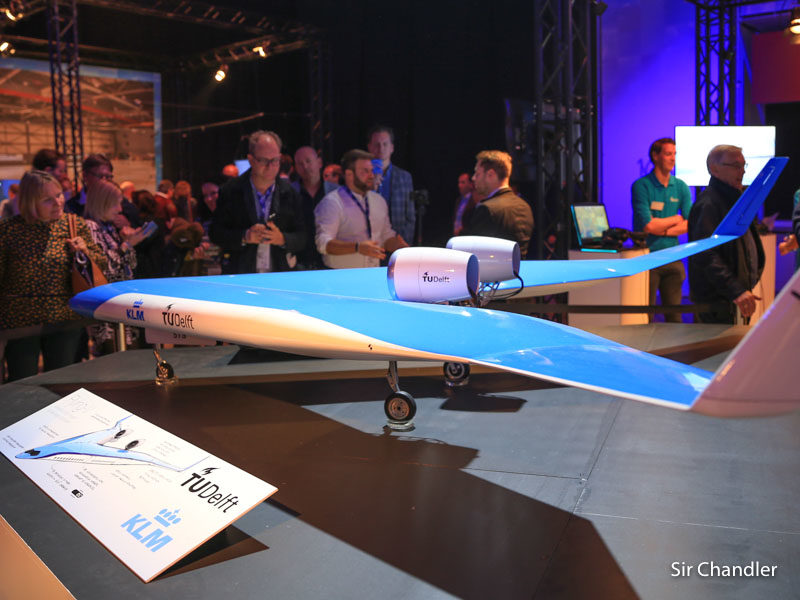En septiembre del 2019 cuando fui al cumpleaños número 100 de KLM (la aerolínea más antigua del mundo) en el salón había una maqueta realmente muy rara
Era esta

Que no solo era novedoso en el diseño, también lo era en la concepción del interior, aprovechando espacios y buscando posiciones mejores para tener menos fatiga

Y esto nació de unos investigadores, pero que cuentan con el apoyo de Airbus y de KLM

En una charla uno de los responsables contaba con pasión que estaban preparando la maqueta para que volara… y eso sucedió hace pocos días. Este es el video oficial que está muy bien hecho y ayuda a imaginar la emoción de esos «locos» que están con el proyecto que un poco se los escucha cuando chequean velocidad, altitud… de este avión tan particular
Tengo info en inglés sobre el proyecto que pego acá abajo, pero tienen que comenzar las pruebas de motores…
This summer, a team of researchers, engineers and a drone pilot of TU Delft travelled to an airbase in Germany for the first real test flight of the scaled flight model of the energy-efficient aircraft design called the Flying-V. The project was announced last year together with KLM. After a period of extensive wind tunnel testing and a series of ground tests in the Netherlands, it was time to perform the first flight and obtain an impression of the flight characteristics. The aircraft had a very successful maiden flight.
Project leader Dr Roelof Vos and his team of researchers and engineers took the 22.5 kg and 3 m wide scale model of the Flying-V for flight tests to a well-guarded airbase in Germany, where they could work together with a team from Airbus. The pilot’s task was to take-off, fly a number of test manoeuvres and approaches until the batteries were nearly empty and land. And he succeeded. Vos: “One of our worries was that the aircraft might have some difficulty lifting-off, since previous calculations had shown that ‘rotation’ could be an issue. The team optimized the scaled flight model to prevent the issue but the proof of the pudding is in the eating. You need to fly to know for sure.” Rotation on take-off was performed easily and occurred at a speed of 80 km/h. The plane’s thrust was good and flight speeds and angles were as predicted.
But testing new technology is never straightforward. The team had a challenging week in which they had to change the centre of gravity of the aircraft and fix the antenna to improve telemetry. The flight has now also confirmed that the current design still shows too much ‘Dutch roll’, causing a slightly rough landing. A next step for the team is to use the data collected during the flight for an aerodynamic (software) model of the aircraft. This will make it possible to programme it in a flight simulator to be used in future research , while further improving the flight characteristics. The team will also prepare the scale model for future flight tests.
The Flying-V
The Flying-V is a design for a highly energy-efficient long-distance aeroplane. The aircraft’s design integrates the passenger cabin, the cargo hold and the fuel tanks in the wings, creating a spectacular V-shape. Computer calculations have predicted that the aircraft’s improved aerodynamic shape and reduced weight will reduce fuel consumption by 20% compared to today’s most advanced aircraft. KLM has been a partner in the project since 2019. Also due to their support, the project team has been able to build this scale model. It was first presented at the 100th anniversary of KLM in October 2019. Various business partners are now involved in the project, including Airbus. Airbus is also an explicit supporter for the first flight. The partners are working together on a research plan to fine-tune the concept. Next step: providing the Flying-V with sustainable propulsion, taking into account that the design seems highly suitable to carry liquid hydrogen instead of kerosene.
¿Serán así los aviones en el futuro?
De estas cosas siempre sale algo…
Descubre más desde Sir Chandler
Suscríbete y recibe las últimas entradas en tu correo electrónico.



Mirá si te toca en el ala derecha y el baño está a la izquierda! jejeje
jajajaja
Yo se que es la excelente edición, la música, el video, todo el suspense, etc, pero me tembló la garganta después del despegue y cuando el Ingeniero se quiebra… qué lindo momento. Te transmite la descarga de stress, emocionante. Interesante tema, gracias por compartir!
Totalmente!!!! porque además la gente del video la vi en vivo y te hablaban con tanta pasión de que ESO podía volar… O sea años esperando esto seguro!!
Pusiste: «Voló» y pense que se la habian afanado!
😉
Yo también pensé lo mismo, jajajajajaja
Es divertido ver estas cosas locas, pensar un poco fuera de la caja
Que onda la pagina hoy? Se cayo cual HomeBanking! Cuanto esta el dolar SirChandler??
jajajaj estaban buscando dólares acá!!! desde ayer estaba jodida… ahora anda bien 😉
el aterrizaje no debe haber sido nada lindo…
por que no lo pusieron??? jajaja
Efectivamente se estroló en el aterrizaje:
Crash bij de landing, maar testvlucht toont: futuristische Flying-V kan vliegen
Pensé exactamente lo mismo JAJAJAJAJAJAJAJAJA
Que lindo ver gente que le pone tanta pasión a un proyecto tan loco e innovador! De estos locos surgen los inventos más increíbles!
Un saludo querido Sir
🙂
PD: contando los días para tu primer crónica a bordo de este avión
seria la gloria!!!
que es eso ? para meterse en esos asientos supongo que seran hidraulicos, porque no me imagina una azafata levantadome a mi para meterme ahi adentro
Jajaja. Es algo conceptualmente raro. Pero es para seguirlo!
Me encanta, pero… ¿no sera un problema para los aeropuertos? ¿no tendrán que diseñar espacios espaciales para estos bichos?
No sé el tamaño real. Pero seguro si necesitará espacios distintos
En los videos explican que tiene un tamaño menor a un Airbus 350 y por eso gastaría (en teoría) hasta 20% menos combustible, y no requeriría adaptar los aeropuertos hasta donde se sabe
The aircraft was originally conceptualised as a potential aircraft design for the future, but can be compared to today’s most advanced aircraft, the Airbus A350. Although the plane is not as long as the A350, it does have the same wingspan. This will enable the Flying-V to use existing infrastructure at airports, such as gates and runways, without difficulty and the aircraft will also fit into the same hangar as the A350. What’s more, the Flying-V will carry the same number of passengers – 314 in the standard configuration – and the same volume of cargo, 160m3. The Flying-V will be smaller than the A350, giving it less aerodynamic resistance.
En el minuto 3:05 se un casi tail strike!!!! jeje (perdón, es la falta de vuelos)
ajajaj
Emocionante momento el del despegue!! Lo disfruté casi cómo si fuera yo el q lo desarrolló!! 🙂
🙂
Que bueno ver gente joven con proyectos tan jugados…me quedé con las ganas de ver el aterrizaje ♀️
Airbus Commercial Aircraft formation flight: 50-year anniversary
[Vuelo en formación de Airbus Commercial Aircraft: 50 aniversario]
https://youtu.be/JS6w-DXiZpk